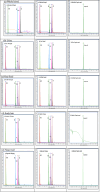SPE-UHPLC-ESI-MS/MS Analysis of Cocaine and Its Metabolites in Conventional and Alternative Biological Specimens: Application to Real Samples
- PMID: 38854579
- PMCID: PMC11154955
- DOI: 10.1021/acsomega.3c09669
SPE-UHPLC-ESI-MS/MS Analysis of Cocaine and Its Metabolites in Conventional and Alternative Biological Specimens: Application to Real Samples
Abstract
An increase in cocaine abuse has been observed globally since the past decade. Cocaine is among the commonly abused stimulants used for recreational purposes. In this study, the SPE-UHPLC-MS/MS method was developed and validated to be applied on real specimens of 20 chronic cocaine abusers to quantify cocaine/metabolites in conventional as well as alternative biological matrices. Cocaine was extracted from biological specimens using solid-phase extraction followed by liquid chromatography tandem mass spectrometry analysis. Chromatographic separation was achieved on a Poroshell120EC-18 column (2.1 mm × 50 mm, 2.7 μm particle size) using water-acetonitrile in 0.1% formic acid as a mobile phase in gradient elution mode. The flow rate of the mobile phase was 0.5 mL/min with a gradient varying the percentage of acetonitrile linearity ranging 15-95% in 6.0 min acquisition time, and the injection volume was set at 5 μL. Positive electrospray ionization with multireaction ion monitoring mode using two ion transitions for cocaine/metabolites and one for cocaine-d3 was employed. The quantification method demonstrated good linear ranges of 0.025-250 ng/mL in blood, urine, and oral fluid (ng/mg for hair and nail) with a ≥0.991% determination coefficient. The detection limit and lower quantification limit were 0.005 and 0.025 ng/mL in all matrices, respectively. The mean extraction recovery and ionization suppression ranged from 89.3 to 99.8% and -4.6 to -14.4% in the studied matrices. Within-run and between-days precisions were 1.8-7.2% and 1.9-6.1%, respectively. This study will not only help in quantifying cocaine/metabolites in alternative specimens (hair, nail, and oral fluid) but also guide clinical and forensic toxicologists in interpretation of exhumation cases. Furthermore, multiple specimens' analyses can be of significance in estimating the time/manner of drug exposure, in confirming the results of laboratories in cases of doubtful clinical histories, or in aiding medico-legal investigations.
© 2024 The Authors. Published by American Chemical Society.
Conflict of interest statement
The authors declare no competing financial interest.
Figures

Similar articles
-
Assessment of pheniramine in alternative biological matrices by liquid chromatography tandem mass spectrometry.Forensic Sci Med Pathol. 2024 Dec;20(4):1291-1302. doi: 10.1007/s12024-024-00795-7. Epub 2024 Mar 26. Forensic Sci Med Pathol. 2024. PMID: 38530580
-
Electrospray ionization tandem mass spectrometry for the simultaneous determination of opiates and cocaine in human hair.Anal Chim Acta. 2011 Oct 17;704(1-2):123-32. doi: 10.1016/j.aca.2011.08.013. Epub 2011 Aug 11. Anal Chim Acta. 2011. PMID: 21907029
-
[Determination of sixteen antibiotics and four β-agonists in human urine samples using ultra-performance liquid chromatography-tandem mass spectrometry based on high-throughput automatic solid-phase extraction].Se Pu. 2023 May 8;41(5):397-408. doi: 10.3724/SP.J.1123.2022.08025. Se Pu. 2023. PMID: 37087605 Free PMC article. Chinese.
-
[Determination of chlorpropham residues in animal-derived foods by solid phase extraction and ultra-high performance liquid chromatography-tandem mass spectrometry].Se Pu. 2022 Jan;40(1):41-47. doi: 10.3724/SP.J.1123.2021.02009. Se Pu. 2022. PMID: 34985214 Free PMC article. Chinese.
-
[Determination of ten aminoglycoside residues in eggs by mixed-mode ion exchange liquid chromatography-tandem mass spectrometry].Se Pu. 2021 Dec;39(12):1374-1381. doi: 10.3724/SP.J.1123.2021.02027. Se Pu. 2021. PMID: 34812011 Free PMC article. Chinese.
References
-
- United Nations office on Drug and Crime (UNODC) World Drug Report 2023 2023.http://www.unodc.org.
-
- Baselt R. C. (2020) Cocaine. In Disposition of toxic drugs and chemicals in man, 12th ed. Biomedical Publications: Seal Beach, CA, pp 497–501.
-
- Daniel S. I., (2020) Cocaine. In Barry S. L.; Sarah K. (eds.), Principles of forensic toxicology, 5th ed., Chapter 23. Springer Nature: Switzerland, AG, pp 371–387.
-
- Molina D. K. (2019) Cocaine. In Handbook of forensic toxicology for medical examiners, 2nd ed. CRC Press, Taylor & Francis Group: Boca Raton, FL, pp 65.
-
- Phipps R. J.; Smith J. J.; Darwin W. D.; Cone E. J. Current methods for the separation and analysis of cocaine analytes. Handbook of Analytical Separations 2008, 6, 73–125. 10.1016/S1567-7192(06)06002-5. - DOI
LinkOut - more resources
Full Text Sources
Miscellaneous
